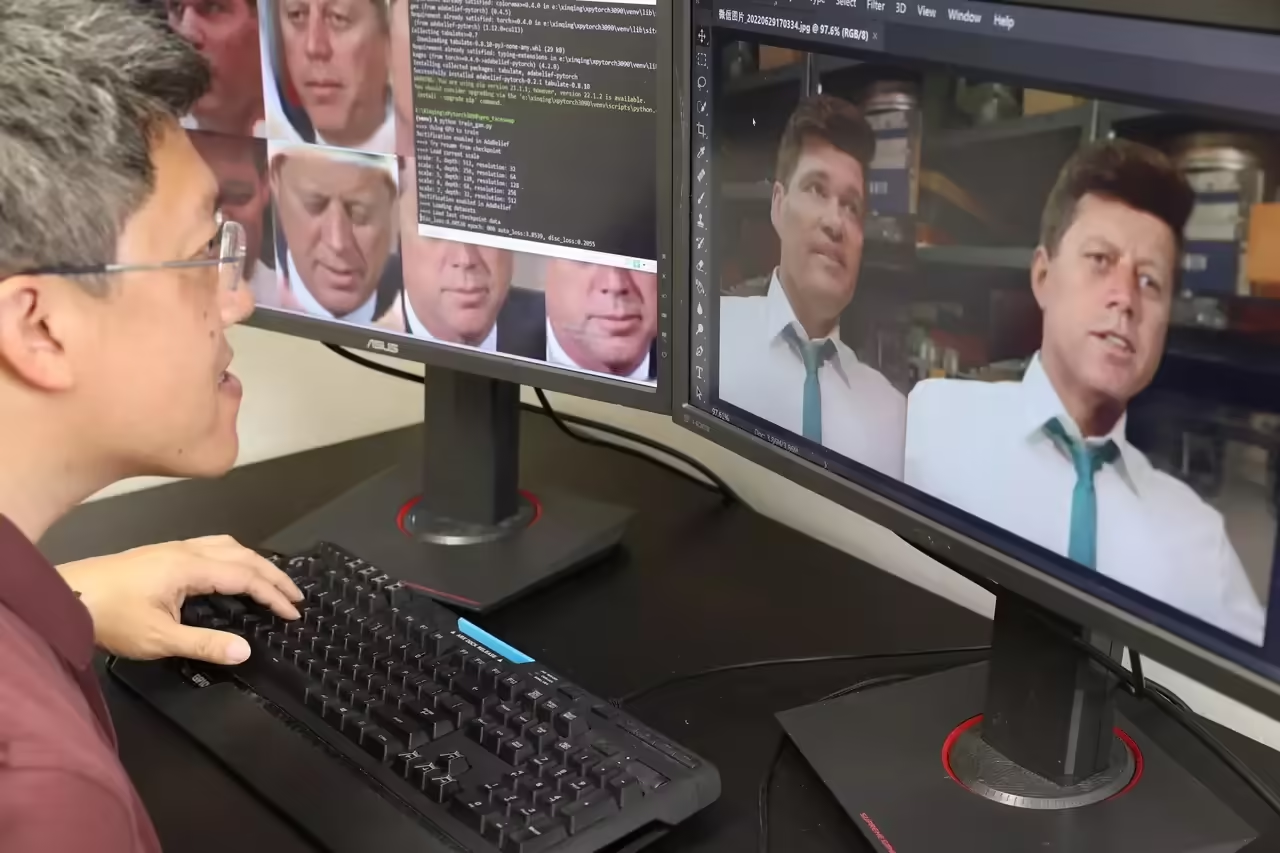
In the world of filmmaking, a new revolution is underway, one driven by the incredible capabilities of artificial intelligence (AI). It’s a revolution that’s changing the way we conceive, produce, and enjoy movies, and it’s rapidly shaping the future of the film industry.
At the heart of any great film lies a captivating story. AI is now being harnessed to help screenwriters and directors craft compelling narratives. With the ability to analyze vast datasets of past movies, AI can predict story arcs, character development, and even dialogue that is likely to resonate with audiences. This not only speeds up the creative process but also opens up new avenues for storytelling experimentation.
One of the most intriguing applications of AI in cinema is in the role of the director. AI systems can analyze scripts and make creative decisions about camera angles, lighting, and pacing. Some experimental projects have even used AI to direct entire scenes. While this doesn’t replace the artistic touch of human directors, it provides valuable insights and options for filmmakers, allowing them to explore different creative directions.
Visual effects and animation have long been integral to the magic of cinema. AI is taking these elements to new heights. AI algorithms can generate incredibly realistic CGI (Computer Generated Imagery), making it challenging for the audience to distinguish between computer-generated and real-world footage. This enables filmmakers to create awe-inspiring visuals and scenes that were once thought impossible.
Writing a screenplay is a laborious process that can take months or even years. AI-driven tools can assist screenwriters by generating dialogue, suggesting plot twists, and ensuring consistency in character behavior. While human creativity remains essential, AI streamlines the writing process, making it more efficient and accessible.
AI has introduced us to the concept of virtual actors. These digital beings can convincingly portray characters, reducing the need for physical actors and their limitations. Virtual actors can take on any appearance, age, or gender, and they’re not bound by time or space. This technology has the potential to revolutionize casting and character creation.
Challenges and Ethical Considerations
As we embrace the future of cinema with AI, we must also address the challenges and ethical considerations it presents. Questions about copyright, privacy, and the impact on traditional filmmaking practices need to be carefully considered. The balance between human creativity and AI assistance is an ongoing discussion in the industry.
AI-Generated Script: The New Era of Cinematic Writing
Cinematic writing has always been an art that melds human creativity with visual storytelling. However, in today’s era, artificial intelligence (AI) is emerging as a powerful tool that is transforming the way cinematic scripts are created.
The AI-Powered Scriptwriting Revolution
Scriptwriting is a creative and often challenging task that demands time and expertise. AI is revolutionizing this process by offering assistance in various areas.
Data Analysis: AI algorithms can analyze vast volumes of scripts and provide writers with valuable insights into story structure, character development, and dialogue quality. This enables writers to make more informed decisions.
Creative Suggestions: AI can generate creative suggestions such as unexpected plot twists or impactful dialogues, enriching the narrative and surprising the audience.
Genre and Style Adaptation: AI can adapt the tone and style of a script to fit a specific cinematic genre, providing writers with greater creative versatility.
Collaborative Creativity with AI
Rather than replacing writers, AI is being used as a collaborative tool. Writers can work alongside AI systems to develop plots, dialogues, and characters more efficiently and effectively. This accelerates the writing process and allows writers to focus on more creative aspects of storytelling.
Challenges and Ethics
Despite its advantages, the integration of AI into cinematic scriptwriting poses ethical and creative challenges. Some argue that human creativity is irreplaceable and that excessive reliance on AI could homogenize stories and reduce originality.
Furthermore, the issue of authorship is a significant concern. Who is the author of a script generated in collaboration with an AI? These ethical and legal questions must be addressed as AI plays an increasingly significant role in scriptwriting.
The Art of Automated Editing: AI in Cinematic Post-production
Video editing is a cornerstone of post-production, where countless hours of footage are meticulously crafted into a cohesive narrative. AI is transforming this process in numerous ways:
Automated Scene Recognition: AI algorithms can analyze video content and automatically identify scenes, making it easier for editors to navigate through hours of footage efficiently.
Enhanced Efficiency: AI-powered video editing tools can automate routine tasks, such as color correction, noise reduction, and stabilization, allowing editors to focus on the creative aspects of their work.
Instant Feedback: AI can provide real-time feedback on editing choices, suggesting cuts, transitions, or even alternative takes based on historical data and film aesthetics.
Language-Based Editing: Natural language processing AI can transcribe and translate dialogues, facilitating the editing process for multi-language films and improving accuracy in subtitles.
Visual Effects and CGI Augmented by AI
Visual effects (VFX) and computer-generated imagery (CGI) have long been essential in filmmaking, but the integration of AI has taken these elements to new heights:
Realistic VFX: AI-driven software can seamlessly integrate live-action footage with computer-generated effects, creating astonishingly realistic visuals while reducing production costs.
Character Animation: AI can replicate human movement and facial expressions, allowing for lifelike CGI characters that interact convincingly with live actors.
Historical Recreation: AI can accurately recreate historical settings, characters, and events, offering filmmakers the ability to transport audiences to any time or place.
Sound Editing and Mixing Enhanced by AI
Sound is a critical component of cinematic storytelling, and AI is making significant contributions to sound editing and mixing:
Automated Sound Restoration: AI can clean up audio recordings by removing background noise, enhancing dialogue clarity, and restoring damaged or degraded audio.
Adaptive Soundtracks: AI algorithms can generate adaptive soundtracks that respond to the emotional tone of a scene, heightening the impact of the film’s score.
Dialogue Replacement: AI can synchronize dubbed dialogues more accurately, improving the quality of foreign-language releases.
Challenges and Artistic Considerations
While AI is revolutionizing post-production, it also presents challenges and raises artistic questions. Some argue that the reliance on AI tools may diminish the unique touch of human creativity in editing, VFX, and sound design. Additionally, ethical considerations regarding the use of AI in manipulating content and generating deepfakes need to be addressed.
Virtual Actors: How AI is Creating Amazing Digital Characters
Traditionally, bringing digital characters to life has been a labor-intensive process that requires skilled animators and extensive resources. AI is changing this landscape in several profound ways:
Realistic Human Motion: AI algorithms can analyze human movements and replicate them with remarkable accuracy. This means that digital characters can move and emote just like real actors, achieving unprecedented levels of realism.
Customization: Filmmakers can tailor digital characters to fit their precise vision, from appearance and clothing to personality traits and expressions.
Historical Accuracy: AI can recreate historical figures with incredible attention to detail, making it possible to bring the past to life on screen.
Endless Creativity: AI can generate entirely new characters, creatures, and species, pushing the boundaries of storytelling and imagination.
Virtual Actors in Action
The use of virtual actors, powered by AI, is not limited to animation. They are making their presence felt in various aspects of filmmaking:
Live-Action Interaction: Virtual actors can seamlessly interact with real actors on screen, enhancing storytelling possibilities and expanding the scope of what’s visually achievable.
Language and Accent Flexibility: AI-driven voice synthesis can provide virtual actors with any accent or language, facilitating multilingual and international productions.
Reducing Production Costs: While the initial setup may require investment, virtual actors can significantly reduce production costs in the long run, as they do not require makeup, costumes, or physical sets.
Challenges and Ethical Considerations
Despite the incredible potential of AI-generated characters, challenges and ethical concerns are part of the equation:
Loss of Human Jobs: The rise of virtual actors could potentially impact the job market for human actors, animators, and makeup artists.
Authenticity and Emotion: Some argue that virtual actors may lack the depth and emotional authenticity of human performances, potentially affecting the emotional resonance of a film.
Ethical Use: The ethical use of virtual actors, especially in situations where they impersonate real people, requires careful consideration to avoid misuse or manipulation.
Empowering Cinematic Dreams: How AI is Revolutionizing Filmmaking for Everyone
Using artificial intelligence (AI) to create films is an ever-evolving field, and as the technology becomes more accessible, ordinary people have the opportunity to engage in AI-assisted filmmaking. Here’s an overview of how regular individuals can utilize AI to create movies:
Access to User-Friendly Tools and Platforms: Companies and developers are creating increasingly user-friendly AI-powered tools and platforms. These applications allow users to create video content using AI for tasks like editing, special effects, and script generation.
AI-Powered Video Editing: AI-driven video editing applications are available to the general public. These tools can automate editing tasks, such as cutting and assembling clips, and provide creative suggestions to enhance the visual quality of videos.
Script Generation and Assisted Writing: AI-based platforms can help users write scripts by offering plot suggestions, dialogues, and narrative structure. Some of these tools can adapt to different film genres and styles.
Streamlined Animation and Special Effects: Applications are being developed that allow users to create animations and special effects using AI. These tools simplify the creation of animated characters and realistic visual effects.
Compiling and Using Visual and Audio Resources: AI platforms can also assist creators in gathering high-quality visual and audio resources, such as images, music, and sound effects, for use in their film projects.
Customized Machine Learning: Some AI applications enable users to train machine learning algorithms to adapt to their creative preferences and specific production needs.
Learning and Experimentation: The key to mastering AI-assisted filmmaking is learning and experimentation. Online tutorials, courses on e-learning platforms, and online communities of content creators can provide guidance and support.
Creative Collaboration: Collaborating with individuals with diverse skills and knowledge, including those with experience in AI and filmmaking, can be an effective way to harness the full potential of AI tools for filmmaking.
While AI is democratizing filmmaking, it’s essential to remember that the creative aspect remains fundamental. AI technology can assist in many tasks, but vision, storytelling, and creativity still heavily depend on human insight. Ordinary people can use AI as a powerful tool to bring their cinematic ideas to life, making filmmaking more accessible and exciting than ever before.







